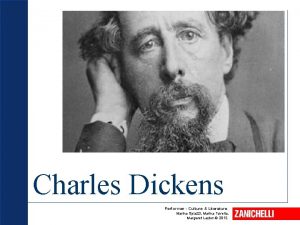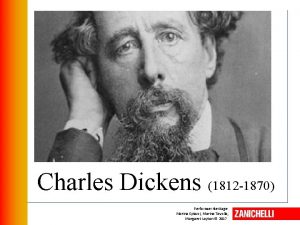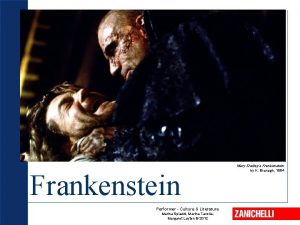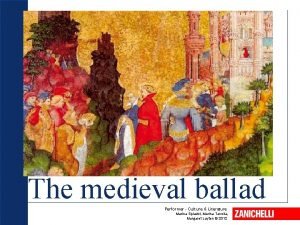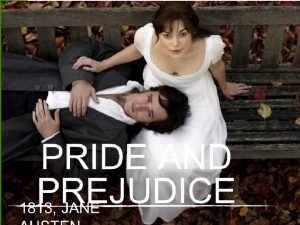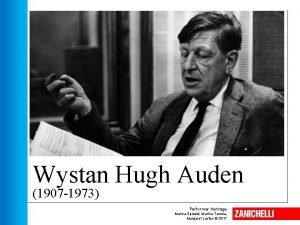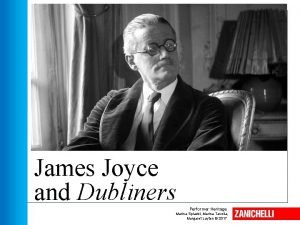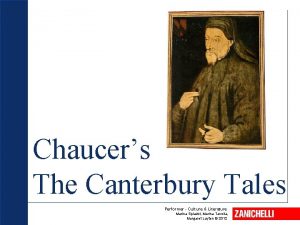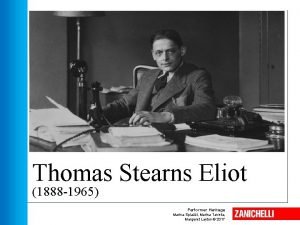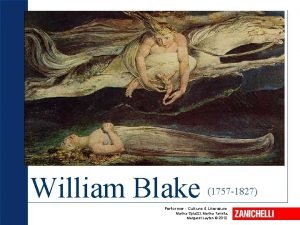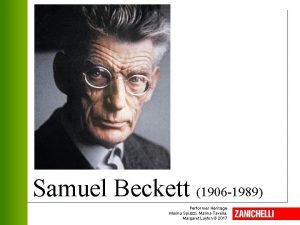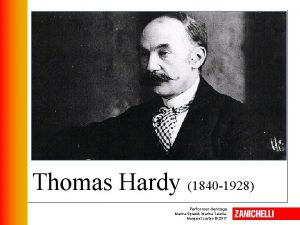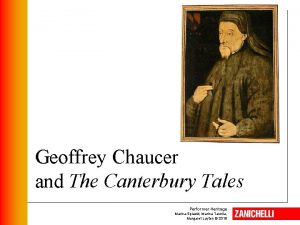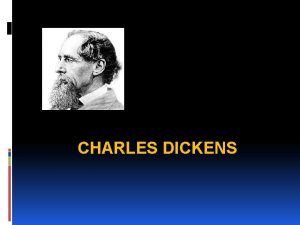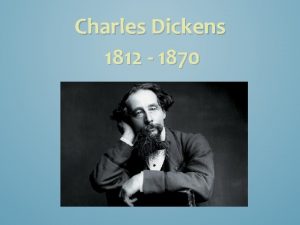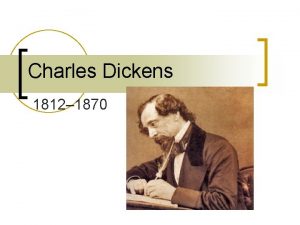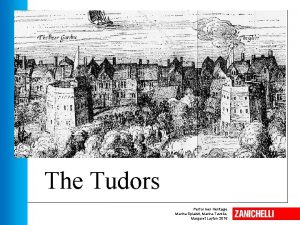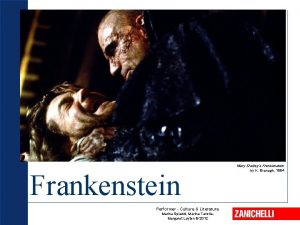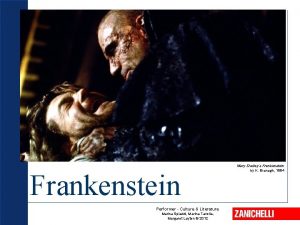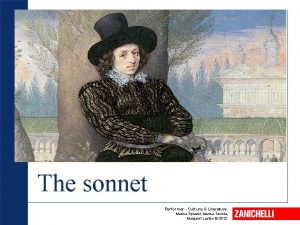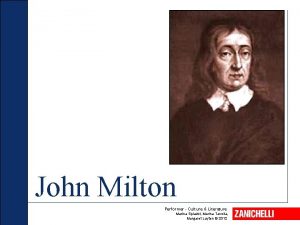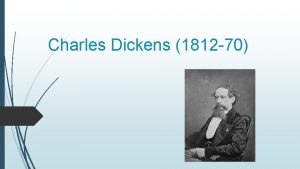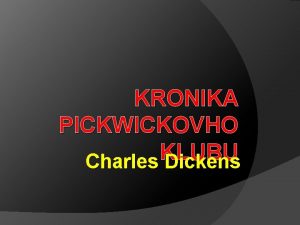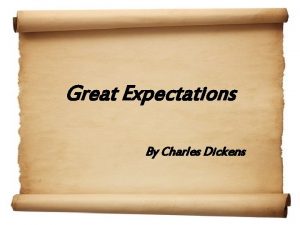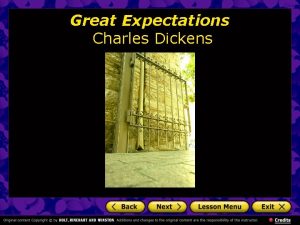Charles Dickens 1812 1870 Performer Heritage Marina Spiazzi



















- Slides: 19

Charles Dickens (1812 -1870) Performer Heritage Marina Spiazzi, Marina Tavella, Margaret Layton © 2017

Charles Dickens 1. Life • Born in Portsmouth in 1812. • Unhappy childhood: he had to work in a factory at the age of 12 (his father went to prison for debts). • He became a newspaper reporter with the pen name Boz. • In 1836 Sketches by ‘Boz’, articles about London people and scenes, were published in instalments. Evert A. Duyckinick, Charles Dickens Performer Heritage

Charles Dickens 1. Life • The protagonists of his autobiographical novels, Oliver Twist (1838), David Copperfield (1850), Little Dorrit (1857), became the symbols of an exploited childhood. • Bleak House (1853), Hard Times (1854), Great Expectations (1861) set against the background of social issues. • Busy editor of magazines. • Died in 1870. Performer Heritage

Charles Dickens 2. The setting of Dickens’s novels Dickens was the great novelist of cities, especially London depicted at three different social levels: • the parochial world of the workhouses its inhabitants belong to the lower-middle classes; • the criminal world murderers, pickpockets living in squalid slums; • the Victorian middle class respectable people believing in human dignity. Detailed description of ‘Seven Dials’, a notorious slum district its sense of disorientation and confinement is clearly expressed in Dickens’s novels. Performer Heritage

Charles Dickens 3. Characters • Dickens shifted the social frontiers of the novel. • The 18 th-century realistic, uppermiddle-class world was replaced by the one of the lower orders. • He depicted Victorian society in all its variety, its richness and its squalor. Performer Heritage

Charles Dickens 3. Characters He created: • caricatures he exaggerated and ridiculed particular social characteristics of the middle, lower and lowest classes; • weak female characters. He was on the side of the poor, the outcast, the working-class. Performer Heritage

Charles Dickens 4. Themes • Family, childhood and poverty. • Dickens’s children are either innocent or corrupted by adults. • Most of these children begin in negative circumstances and rise to happy endings which resolve the contradictions in their lives created by the adult world. Performer Heritage

Charles Dickens 5. Aim • Dickens tried to persuade the common intelligence of the country to alleviate social sufferings. • He was a campaigning novelist and his books highlight all the great Victorian controversies: 1. The faults of the legal system Oliver Twist, Bleak House. 2. The horrors of factory employment David Copperfield, Hard Times. 3. Scandals in private schools David Copperfield. 4. The appalling living conditions in the slums Bleak House. Performer Heritage

Charles Dickens 6. Style Dickens’s style very rich and original. The main stylistic features of his novels are: • long list of objects and people; • adjectives used in pairs or in groups of three and four; • several details, not strictly necessary; • repetitions of the same words and sentence structures; • the same concepts are expressed more than once, but with different words; • use of antithetical images and ideas in order to underline the characters’ features; • exaggeration of the characters’ faults; • suspense at the end of the episodes or introduction of a sensational event to keep the readers’ interest. Performer Heritage

Charles Dickens 7. Oliver Twist (1838) • This Bildungsroman (an ‘education’ novel) appeared in instalments in 1837. • It fictionalises the humiliations Dickens experienced during his childhood. • The protagonist, Oliver Twist, is always innocent and pure and remains incorruptible throughout the novel. • At the end he is saved from a life of villainy by a well-to-do family. Performer Heritage Oliver asks for more.

Charles Dickens 7. Oliver Twist (1838) The setting is London. Dickens attacked: • the social evils of his times such as poor houses, unjust courts and the underworld; • the world of the workhouses founded upon the idea that poverty was a consequence of laziness; • the officials of the workhouses because they abused the right of the poor as individuals and caused them further misery. Performer Heritage

Charles Dickens 8. Hard Times (1854) • It is a ‘denunciation novel’ a powerful accusation of some of the negative effects of the industrial society. • The setting the fictional city of Coketown, which stands for a real industrial mill town in mid 19 th-century Victorian England. Performer Heritage

Charles Dickens 8. Hard Times (1854) • Characters people living and working in Coketown, like the protagonist Thomas Gradgrind, an educator who believes in facts and statistics. His school tries to turn children into little machines that behave according to such rules. Performer Heritage

Charles Dickens 8. Hard Times (1854) Themes: • a critique of materialism and Utilitarianism; • a denunciation of the ugliness and squalor of the new industrial age; • the gap between the rich and the poor. Aim to illustrate the dangers of allowing people to become like machines and to suggest that without compassion and imagination, life would be unbearable. Performer Heritage

Charles Dickens 9. Dickens’s universality Dickens’s work transcends his time, language and culture. Dickens’s legacy: 1. He was the man who invented the idea of a white Christmas. A famous writer stated: ‘Whether the Christmas visions would or would not convert Scrooge, they convert us. ’ (G. K. Chesterton, 2007) Performer Heritage

Charles Dickens 9. Dickens’s universality 2. ‘Dickensian’ poverty Dickens was one of the first to describe the underclass and the poverty stricken in Victorian London. ‘Dickensian’ it has become the easiest word to describe an unacceptable level of poverty. The labour houses of Bethnal Green in East London. Performer Heritage

Charles Dickens 9. Dickens’s universality 3. Modern character comedy the comic potential of the way his characters talk. 4. The cinema Dickens was a key and important influence in cinema development. He invented the parallel montage where two stories run alongside each other and the close-up. Performer Heritage

Charles Dickens 9. Dickens’s universality 5. Meaningful names he refined the practice to suggest characters’ traits and their role. Some characters have become so recognisable that they have entered the language as nouns for example, a scrooge = somebody meanspirited or lacking in generosity. Performer Heritage

Charles Dickens 9. Dickens’s universality 6. Our view of the law the current view of lawyers seems to be partly inspired by characters such as the menacing lawyer Mr Tulkinghorn in Bleak House. Dickens was very critical of the way the law discriminated against the poor. What remains of the issues highlighted by Dickens the cost of the legal proceedings, particularly with small civil claims, is bound to exceed the damages that are obtained. Performer Heritage
 Charles dickens performer heritage 2
Charles dickens performer heritage 2 Charles dickens performer heritage
Charles dickens performer heritage Marina spiazzi
Marina spiazzi Performer heritage frankenstein
Performer heritage frankenstein Marina spiazzi
Marina spiazzi Ababcdcdefef
Ababcdcdefef Performer heritage 1 pdf
Performer heritage 1 pdf Performer heritage 2
Performer heritage 2 Performer heritage pdf download
Performer heritage pdf download Soluzioni performer heritage 2 eveline
Soluzioni performer heritage 2 eveline Estate satire in canterbury tales
Estate satire in canterbury tales Eliot marina
Eliot marina George orwell powerpoint zanichelli
George orwell powerpoint zanichelli William blake ppt zanichelli
William blake ppt zanichelli The theatre of the absurd zanichelli
The theatre of the absurd zanichelli Key ideas performer heritage
Key ideas performer heritage Geoffrey chaucer performer heritage
Geoffrey chaucer performer heritage Stream of consciousness literature
Stream of consciousness literature World heritage is our heritage slogan
World heritage is our heritage slogan Classification of property under hindu law
Classification of property under hindu law
